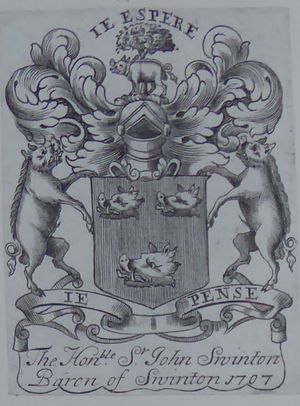Difference between revisions of "John Swinton d.1723"
(new record) |
m (typo and edit) |
||
| (One intermediate revision by one other user not shown) | |||
| Line 1: | Line 1: | ||
__NOTITLE__ | __NOTITLE__ | ||
===Sir [[name::John]] [[name::SWINTON]] 25th [[personal title::laird of Swinton]], d.[[date of death::1723]]=== | ===Sir [[name::John]] [[name::SWINTON]] 25th [[personal title::laird of Swinton]], d.[[date of death::1723]]=== | ||
| − | + | [[file:P1120502(5).JPG|thumb|Swinton's bookplate (British Museum Franks Collection *580)]] | |
====Biographical Note==== | ====Biographical Note==== | ||
The second son of [[family::John Swinton]] (d.1679), of Swinton in Berwickshire, and his wife [[family::Margaret Stewart|Margaret]], daughter of William Stewart, 2nd Lord Blantyre. Swinton's father was an active politician during the Protectorate and had had his estates forfeited at the Restoration. | The second son of [[family::John Swinton]] (d.1679), of Swinton in Berwickshire, and his wife [[family::Margaret Stewart|Margaret]], daughter of William Stewart, 2nd Lord Blantyre. Swinton's father was an active politician during the Protectorate and had had his estates forfeited at the Restoration. | ||
| − | The younger Swinton | + | The younger Swinton became a successful merchant in the Netherlands. He succeeded his elder brother as head of the family in 1687 and returned to Scotland at the time of the accession of William and Mary. |
In 1689 he was appointed a [[occupation::commissioner of supply for Berwickshire]] and the following year was restored to his father's estates. From 1690 until 1707 he was a commissioner for Berwickshire in the Parliament of Scotland. He became a [[occupation::director of the Company of Scotland]] and [[occupation::director|of the Bank of Scotland]] in 1695, incurring huge losses during the Darien Scheme. | In 1689 he was appointed a [[occupation::commissioner of supply for Berwickshire]] and the following year was restored to his father's estates. From 1690 until 1707 he was a commissioner for Berwickshire in the Parliament of Scotland. He became a [[occupation::director of the Company of Scotland]] and [[occupation::director|of the Bank of Scotland]] in 1695, incurring huge losses during the Darien Scheme. | ||
Latest revision as of 00:11, 3 May 2021
Sir John SWINTON 25th laird of Swinton, d.1723
Biographical Note
The second son of John Swinton (d.1679), of Swinton in Berwickshire, and his wife Margaret, daughter of William Stewart, 2nd Lord Blantyre. Swinton's father was an active politician during the Protectorate and had had his estates forfeited at the Restoration.
The younger Swinton became a successful merchant in the Netherlands. He succeeded his elder brother as head of the family in 1687 and returned to Scotland at the time of the accession of William and Mary. In 1689 he was appointed a commissioner of supply for Berwickshire and the following year was restored to his father's estates. From 1690 until 1707 he was a commissioner for Berwickshire in the Parliament of Scotland. He became a director of the Company of Scotland and of the Bank of Scotland in 1695, incurring huge losses during the Darien Scheme.
He was knighted before September 1696 and made a burgess of Edinburgh in 1707. Swinton supported the Act of Union 1707, and was one of the Scottish representatives to the first Parliament of Great Britain and a commissioner of the Equivalent. He did not stand for Berwickshire at the election of 1708, but remained on the Equivalent commission until it was dissolved in 1719. He supported the Hanoverian succession in 1714.
Books
Used an engraved bookplate (Franks *580) The Honble. Sr. John Swinton, Baron of Swinton. 1707.
The extent and disposition of his library is not known.
Sources
- Gambier Howe, E. R. J. Franks bequest: catalogue of British and American book plates bequeathed to the ... British Museum. London, 1903.
- David Wilkinson, 'SWINTON, Sir John (bef. 1662-1723), of Swinton, Berwicks.' History of Parliament.
